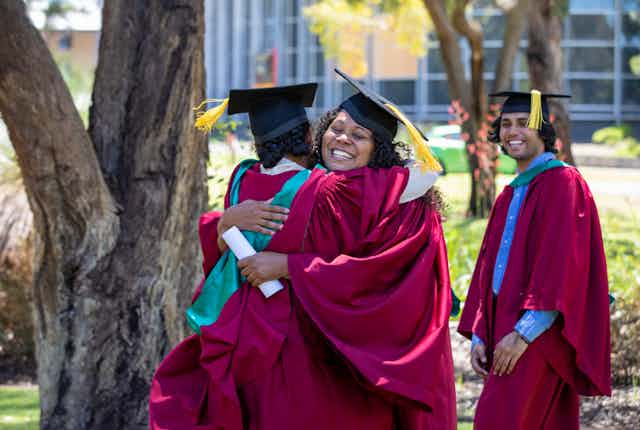The federal government has released the final report on a Universities Accord. Taking more than a year to prepare, it is billed as a “blueprint” for reform for the next decade and beyond. It contains 47 recommendations across student fees, wellbeing, funding, teaching, research and university governance. You can find the rest of our accord coverage here.
The Universities Accord final report calls for meaningful steps to increase the numbers of Indigenous graduates and Indigenous leaders in higher education. In post-referendum Australia, this is more important than ever.
The philosophy of “nothing about us without us” runs through the report, with recommendations for Indigenous leadership in policies, programs, funding and decision-making. Is this enough?
What does the accord recommend?
One of the key recommendations of the report is to raise Indigenous participation at university. The accord wants Australia’s university student population to reflect the demographic composition of Australian society.
It wants to do this by introducing equity targets. At the moment, Indigenous Australians make up 3.7% of the Australian population but only 1.5% of university completions.
In part, it hopes to do this with more government-supported university places for Indigenous students and scholarships.
It also has a strong element of self-determination, with a proposed First Nations-led review of universities and a First Nations council to provide advice to the federal education minister and sector. The report also calls for more Indigenous people in leadership and governance positions within universities.
This is not the first time
While the sentiments in the report are welcome, this is not the first time there have been plans to boost Indigenous enrolment at university. Although previous reports have advocated for increased Indigenous Australian participation at universities, completion rates have remained low.
So we need more than just good intentions or targets. Preparing Indigenous Australian students for university also needs to involve recognising and valuing different pathways into higher education. This should include recognising work experience and preparatory programs (and not just Year 12 results) and/or participation in pre-university experiences and courses.
It also needs to include mentorships, career counselling and work experience in high school.
Once students are enrolled, universities also need to provide support to Indigenous students throughout their study. This may include culturally responsive approaches to teaching, access to support services, and nurturing a sense of belonging on campus.
For example, Indigenous support units for both undergraduate students and postgraduate students are essential. This support must be tailored to the individual needs of each student.

Financial support is a problem
Financial challenges can prevent students from completing their degrees, especially those from low socioeconomic backgrounds, regional areas or Indigenous students.
Rising living costs are exacerbating students’ financial struggles.
Many Indigenous students may also experience intergenerational poverty as a legacy of colonisation. As the National Aboriginal Community Controlled Health Organisation notes, poverty is “reinforced and entrenched” by ongoing experiences of racism.
Our research involving 308 Indigenous Australian students who completed their university degrees between 2018 and 2022 found economic conditions, particularly financial hardship, were one of the key factors affecting Indigenous students’ completion. Students often had to rely on support from family and/or take on work while studying to make ends meet.
So it is vital that Indigenous students get adequate financial support that covers the cost of food, accommodation and study materials. The review suggests financial support to students needs to increase. While costly, this should be a priority.
Approximately 63% of Australia’s Indigenous population also live in outer regional areas or very remote areas.
The report talks at length about boosting infrastructure for regional campuses. This is a crucial component. Indigenous Australians need to be able to study in places close to where they live and that they can easily access.
First Nations review
The report recommends a First Nations-led review of tertiary education with a view to “strengthening” student and university workforce numbers of Indigenous peoples, as well as First Nations knowledge of research.
The Indigenous higher education sector has been calling for reforms for years, which have been documented in various government reports. National Aboriginal and torres Strait Islander Higher Education consortium: Accelerating Indigenous Higher Education consultation paper.
So while this proposed new review sounds like a significant and comprehensive piece of work, it isn’t a new idea. What’s really needed is a commitment to implement recommendations from the years of work by Indigenous experts in the higher education sector, rather than starting a new process.
A call to action
The accord aims to build a more inclusive and equitable higher education for all Australians, but we need to see more detail and timelines for action.
The government is still considering the report and has indicated it will take several budgets to implement.
So at this stage, it is only a call to action. Whether the call will be answered remains to be seen.

